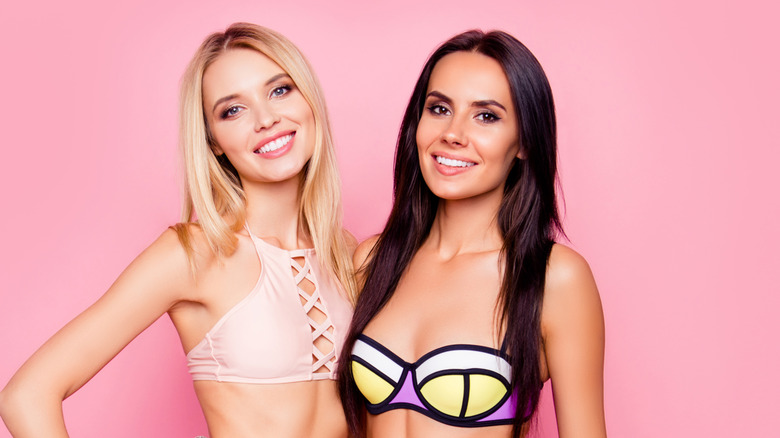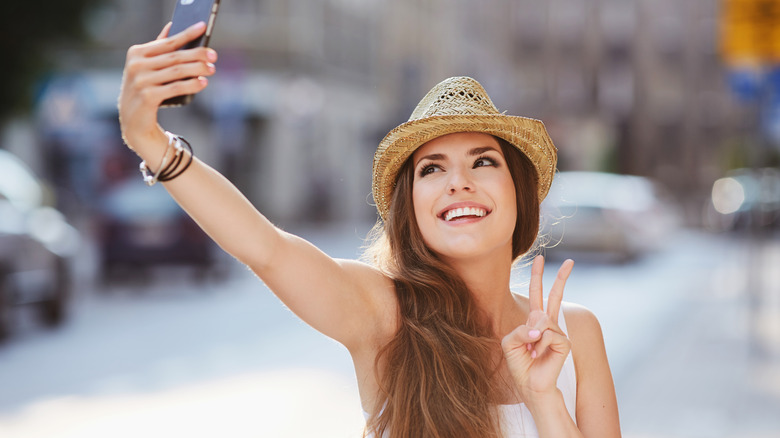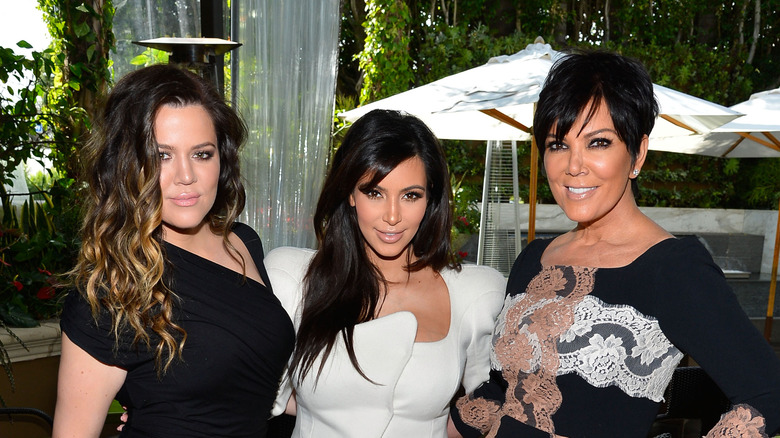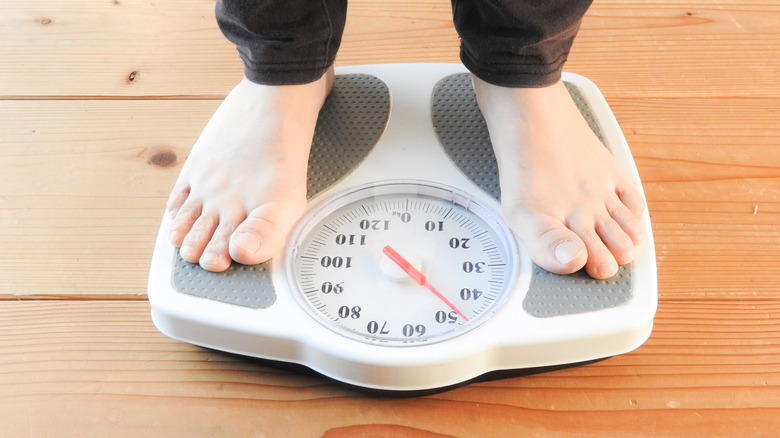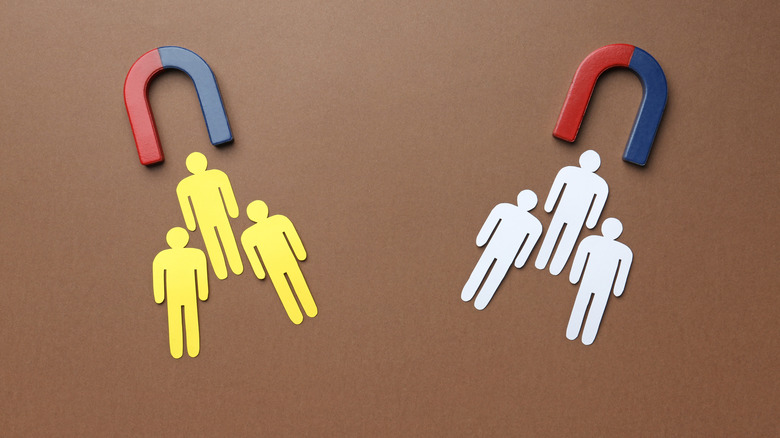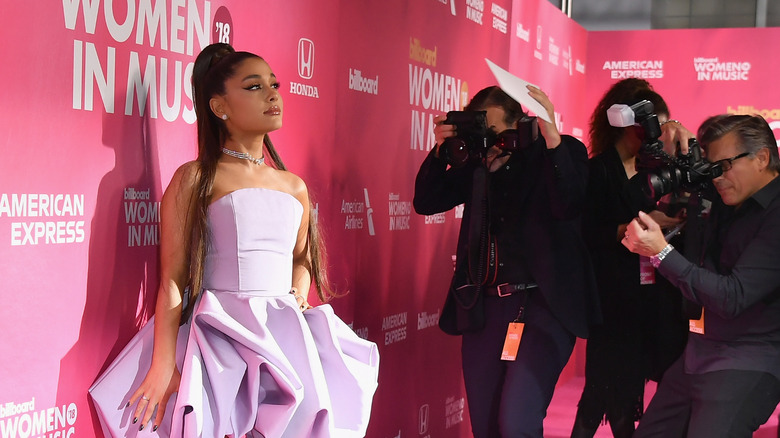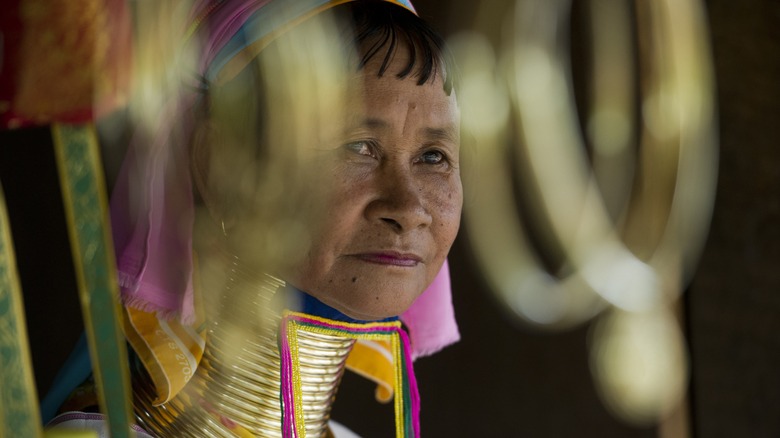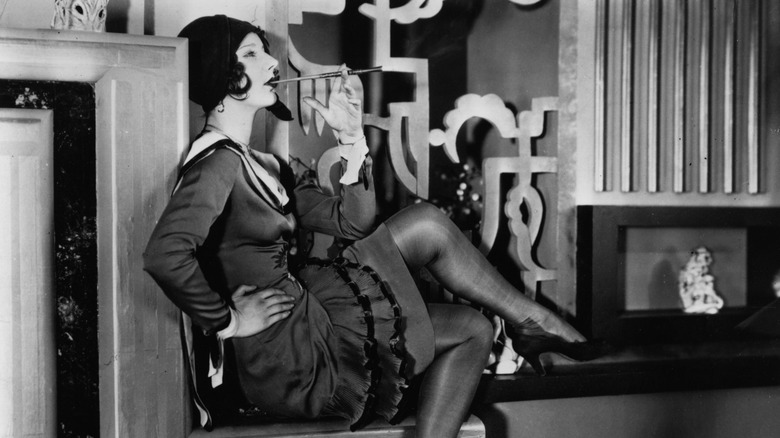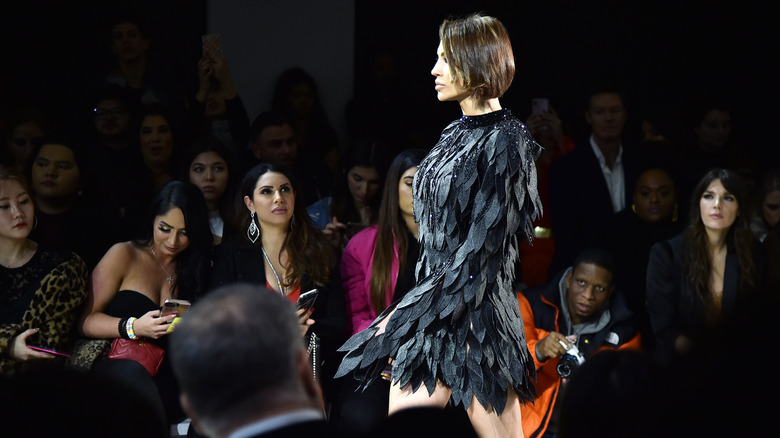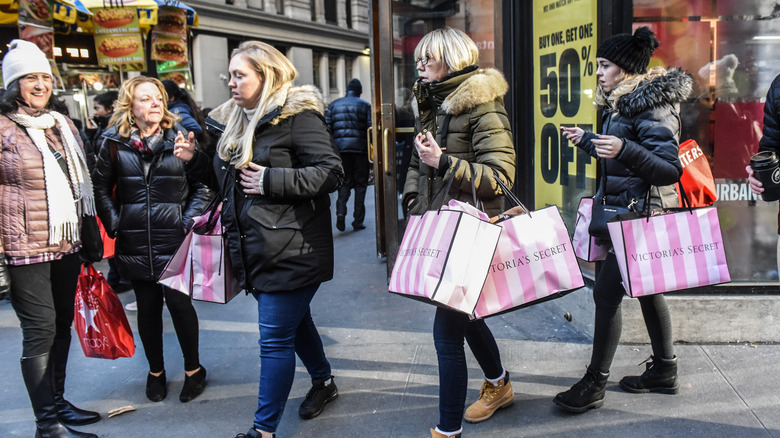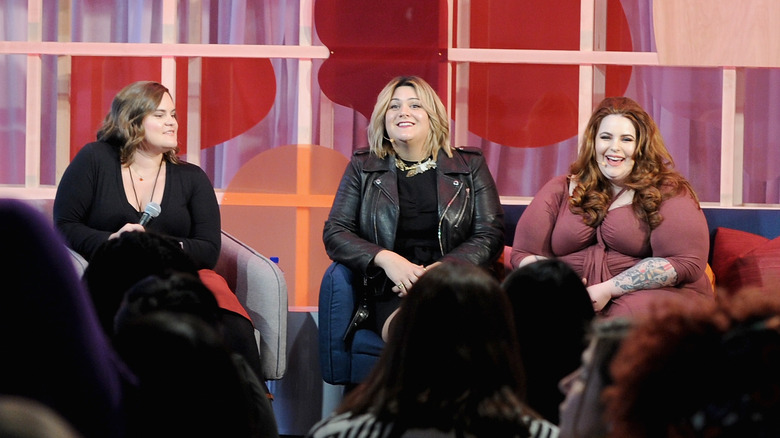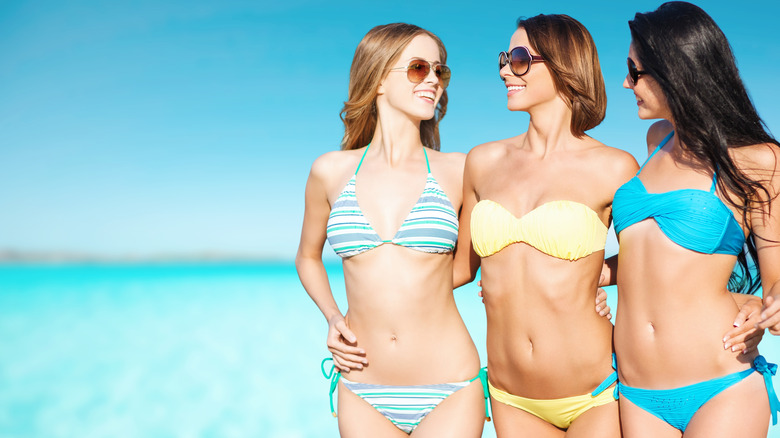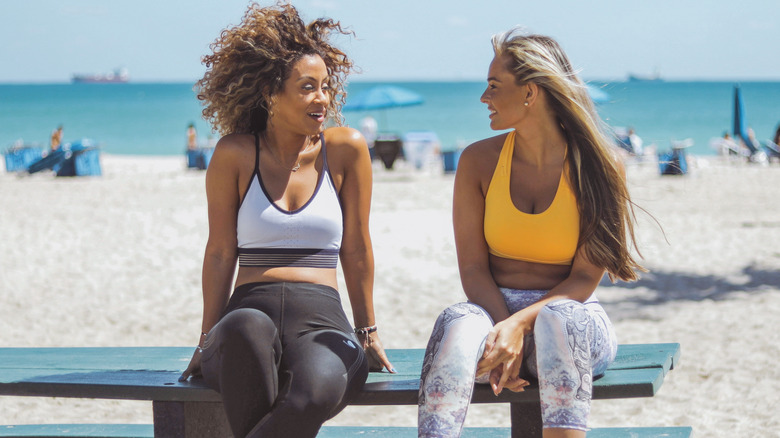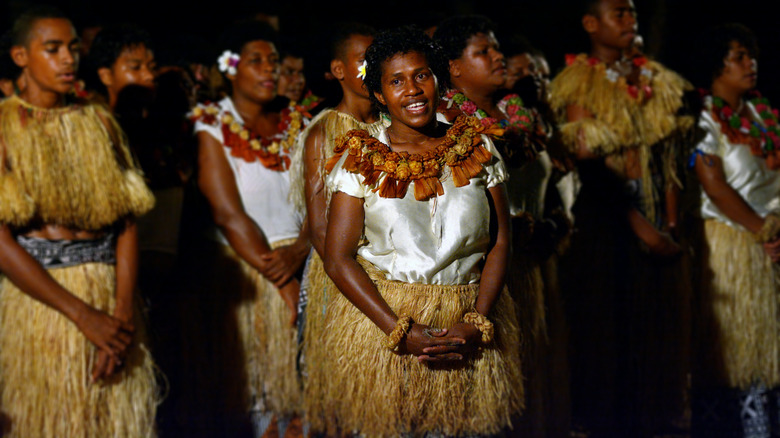Why The 'Perfect Body Type' Is Always Changing
Having the "perfect body type" is something that many people have strived for, sparking their interest in diets and exercise routines. And most people can relate. Who hasn't looked in the mirror and wanted to change what they see? But what's considered "perfect" today might not be seen that way tomorrow, as trends come and go over the years, with specific body traits rising and falling in popularity. From willowy flappers, to Amazonian supermodels, to bootylicious babes, women have stretched and squeezed themselves to fit into whatever particular mold society has crafted for them.
This has led to many women feeling discouraged and dissatisfied with their bodies (via PsychCentral), with some even turning to dangerous methods to change themselves. However, these aforementioned fashion trends show that there is no objective perfect body. Rather, the concept of the "perfect body" is influenced by public's perception of beauty, which is ever-evolving. Here's why the "perfect body type" is always changing.
The effects of social media
We live in an age where words like "baby boomer" and "millennial" get thrown around constantly. The differences between generations may cause many disagreements over politics, economics, and of course, beauty standards. According to a study by Beautycon Media, 82 percent of individuals between the ages of 13 and 34 agree that "physical and digital identities are one and the same." Young people have grown up seeing themselves through pictures posted to social media. And that looking glass has no doubt changed people's relationship to their bodies. Though Time magazine once called technology a "toxic mirror," Beautycon's study found that people's relationship with social media "heightens the diversity of aesthetic expression."
Unlike baby boomers, beauty to younger generations isn't just about what society is telling them to look like — it's about making more of an intimate personal statement. Bodies are becoming more owned by their... well, owner, and that puts into question whether or not an "ideal" body even exists.
Survival of the prettiest
It's an unfortunate fact for most of us that the prettiest people often get the most attention. And, according to scientists, women are continuing to get more and more attractive generation after generation. Evolution expert Dr. Jack da Silva, who works with the University of Adelaide, told ABC News Online, "From an evolutionary perspective, there's a selection in women to be more beautiful," adding, "The study showed that women on a whole are more attractive than men." According to da Silva, men may decide to have families with pretty women because "men choose genetic success based on looks." Women, however, do not, so "being more attractive is more beneficial to women than it is to men."
And oddly enough, Silva found that the more attractive a woman was, the more daughters she would have. If this "beauty race," as da Silva called it, continues, soon enough the world will have a population of beautiful goddesses. On the other hand, that also means that beauty standards may be raised with each new generation.
What is considered healthy?
One would think that what is healthy would be an objective fact, but that's not always the case. It is more what is perceived as healthy that shapes our attitudes about certain body shapes. Psychologist Devendra Singh of the University of Texas told Live Science in an interview, "The idea is that beauty is conveying information about health and fertility, and we admire that." In times of great need, like the Great Depression, appearing too thin was looked down upon, and a more fuller form was preferred. Since then, having extra weight has been a major focus of the health community. The National Institutes of Health (NIH) spent a billion dollars in 2018 researching obesity alone.
However, weight might not be the most accurate barometer for a person's health. One of the most popular measurements of weight is body mass index (BMI), but studies have shown that it isn't a good indicator of cardiovascular wellness (via The New York Times). So, rather than only considering your BMI or the number you see on a scale, it's probably best to instead concentrate on bettering yourself with healthy eating and exercise, which Dr. Arya M. Sharma, the University of Alberta's chairman of obesity research and management, told The New York Times. "You might want to focus on being as healthy as you can and not obsess about your weight," she said. "Obesity management is not about treating numbers on a scale. It's about improving people's health."
We like what we know
We've all heard the saying that opposites attract. However, according to several studies, that's not actually true. According to Medical Daily, researchers at Wellesley College in Massachusetts and the University of Kansas found that students preferred to spend time with like-minded people rather than those with opposite views. It turns out, humans are more attracted to what they are already comfortable with. There's a phenomenon known as the mere-exposure effect, where people simply like others who are familiar to them. For example, growing up, a person generally sees their family members a lot. As noted by Psychology Today, it's not unheard of for people to have a preference for partners that resemble their family.
This apparent phenomenon isn't limited to just families. Friends, peers, and neighbors also feed into our sense of familiarity and can make us feel comfortable. It's part of why everyone has a different idea of what an attractive body looks like. After all, beauty is in the eye of the beholder. That's not to say that people can't find unfamiliar bodies attractive, but, in general, they often gravitate towards what they already know.
Hmm, maybe the mere-exposure effect is part of the reason why the "dad bod" has to taken the world by storm...
The media has our attention
In conjunction to the mere-exposure effect, the media also plays a big role in our lives. For example, if we see a certain image portrayed by the media over and over again, it becomes familiar to us. Most people today consume media through television shows, computers, smartphones, and even magazine covers. It seems nearly impossible to be unaffected by the media and what images are promoted on the small screen and in print. Thus, we are dominated by what scientists call the "thin ideal," as described by University of Ottawa researchers Lisa Mask and Céline M. Blanchard.
It's no secret that Hollywood often focuses on thin women, equating their skinniness with beauty. What's harmful, though, is that this focus can skew a person's perception of the norm. However, it's important to remember that the media shows what they think people want to see. As people's priorities shift, advertisements have started promoting more diverse body types (via CNBC), and that's something we can all get on board with.
On-screen representation
Since the media influences such a huge chunk of our perception, it should come as no surprise that representation of race and diversity — or lack thereof — plays a huge role in our perception of beauty. A report published in 2015 by the Annenberg School for Communication and Journalism showed that 73.1 percent of the roles in the top 100 films were played by white people. The media has a serious focus on white people, and sadly this has an effect on how people of color may see themselves.
This idea has manifested in the popular but dangerous procedure of skin lightening, which, as the procedure's name suggests, aims to lighten skin tone. America's media has started to affect other country's perception of beauty, even when their population is predominantly non-white. A study in India found that 44.6 percent of participants starting using skin lighteners because of TV and advertisements. One of the most popular surgeries in South Korea is blepharoplasty, or double eyelid surgery, according to Business Insider. This widens the eyes to give the patient the double eyelid fold, which many Korean people do not have.
Cultural differences
Most studies on beauty and body image focus on Western countries, but that's only one part of the world. There are cultures like the Tsimané of the Bolivian Amazon that value women for having heavier body weights — not for having thin frames, as noted by a 2014 study. While that may be the complete opposite of the "thin ideal" in American media, it's what is considered attractive in that particular culture. Similarly, other cultures focus on completely different aspects of the body altogether. For example, Padaung women in Myanmar and Thailand wear brass rings around their necks to make them appear longer, as long necks are considered ideal in their culture.
Even just in America, the culture has shifted drastically in the last hundred years. The quintessential, corset-wearing "Gibson Girl" that dominated the late 1890s and early 1900s might have had an hourglass figure, but not many people would put Kim Kardashian under that same label despite her having a similar silhouette. Clearly, there's a lot that goes into people's perceptions of beauty.
Changing lifestyles
The way you live your life could understandably influence your outward appearance. The best historical example of this might just be the iconic flappers of the 1920s. Flappers were known for drinking alcohol, going to parties, and having more sexual freedom than their elders, according to History.com. And the way they presented themselves with their straight, slim bodies appeared to be a rejection of the Victorian images of corseted beauty. Therefore, we imagine that flappers and their contemporaries might have seen twig-like bodies as the ideal.
But while the flappers' draped dresses and short hairstyles are thought of as fashionable today, they were considered rebellious and even "immoral" at the time, as noted by History.com. A New York mother in 1922 once complained to The New York Times, "The boys of today must be protected from the young girl vamp." The United States was so scandalized by these young women showing their skin that many states tried to make their fashion illegal, including Virginia, which tried to ban any dress that showed off more than three inches of a woman's throat. While the image of some puffed-up bureaucrat chasing women around with a ruler might be hilarious, it seems ridiculous that something so tame to modern Americans would be considered so counter-culture to those of the past.
Fashion and clothing trends
The internet is littered with articles illustrating how to dress for your body shape, so that should tell you just how much fashion influences what bodies are "in" and which are "out." This isn't anything new, as one of the most interesting manifestations of this phenomenon began during World War II. As women took over much of the workforce while men went off to war, as noted by History.com, the time's popular fashion became much more practical. No longer was the "perfect body" considered to be delicate and soft. Instead, women's bodies took on a stronger appearance, as people embraced wide shoulders and sharp angles and women's dress looked more and more like a military uniform, according to a blog from the U.S. National Archives.
But this wasn't the only case of fashion influencing society's perception of the ideal body. Many of us are familiar with the near-unattainable standards that the fashion industry has imposed on the everyday woman, as models often weight far less than the average woman. And seeing skinny models walk the runway, of course, shapes what we see as beautiful.
There's profit involved
The depressing truth is that there's profit to be made in making people feel bad about their bodies. The diet food market has been growing six to nine percent a year and is now a $10 billion industry, according to a study conducted by India's Bharathidasan University. Even if suddenly tomorrow all women were content with their bodies, it's still possible these companies would find another way into their pockets. A large reason women shave their armpits and legs is because of Gillette's past marketing tactics. The razor company began running ads for women's razors in 1917, proclaiming that their product solved "an embarrassing personal problem" for ladies' underarms, despite the fact that shaved armpits were not the norm at the time.
Clearly, companies make money off of body dissatisfaction. Though, they do appear to acknowledge when change is on the horizon. More and more companies seem to be embracing body positivity in their advertising strategy. The company behind Dove and Axe, Unilever, for example, has made an effort to change its marketing strategy. Keith Weed, Unilever's chief marketing officer, stated at the 2016 Cannes Lions International Festival of Creativity, "Our industry spends billions of dollars annually shaping perceptions and we have a responsibility to use this power in a positive manner."
The politics of beauty
Let's face it, Americans live in a highly politicized age, and society has a lot to say about what kind of body a person should or should not have. Luckily, there are large organizations that are trying to give the voice back to the people. There are entire movements like The Body is Not an Apology based around body positivity and expanding the idea of what is considered a beautiful body. In its mission statement, the organization claims it was created "to remind us that we do not need to wait to feel beautiful, powerful, or worthy tomorrow."
The dialogue around bodies and body image is changing. The modern body positivity movement is still young, but we're already seeing its effects. Brands are starting to ban altered photos on their products, increase their clothes sizing options, and hire more diverse models. In the future, maybe there won't even be a strict vision of the "perfect body."
Beauty is tied to class
It's not just health that's tied to beauty standards, but also a person's economic and social class — something that's been true around the world throughout human history. For example, in China during the Tang and Song Dynasties, plumpness was a characteristic of the wealthy and powerful, according to Sermo, a physicians' blog. That's why the artwork from that time depicts emperors and other powerful individuals as robust and filled out. Anyone have a time machine handy?
Similar ideals were held during the Renaissance, which occurred at roughly the same time as the Tang and Song Dynasties. Having excess fat on the body was associated with power, success, and wealth. No wonder the paintings of the era depict fleshy, large bodies. That must have been nice!
Unfortunately for many of us, that isn't the case in our contemporary society, where slender bodies are looked up to as the ideal body type. That's because food is plentiful and abundant for most people, and obesity has been linked to other health problems, according to Live Science. So it follows that those with more money have access to doctors, foods, and exercise regimens that help them stay slender.
Attractiveness is tied to morality
When you look at someone and perceive that they're beautiful, of course there's a physical component to making that decision, which happens (where else?) in your brain. But it's more complicated than that, as there's also a moral component to beauty, which your brain perceives in a similar manner, according to a study in Social Cognitive and Affective Neuroscience. So if you see someone beautiful who then does something morally valuable, like save a cat from oncoming traffic or helping a vulnerable person cross the street, odds are you'll find them more beautiful.
To that end, in modern Western society, where fatphobia is rampant, people often falsely associate being fat with negative attributes like being lazy, weak-willed, having poor hygiene — all things that are not in alignment with our cultural morality. Americans tend to value hard work and cleanliness, which is associated with being thin in a fatphobic culture — this, in turn, can have some seriously negative impacts on fat people. That also explains why thinness is almost universally equated to beauty — hence the perfect body being a lean body. But since morality is not fixed and can and has changed, and as precedent has shown, that might not be the case forever.
Racism plays a huge factor
According to Harvard Extension School, racism has a long and complex history in the United States, which of course significantly impacts all areas of life. So it's not surprising that our beauty standards have also been affected by racism — something that's evident when you examine our past, according to Dr. Sasha Turner, an Associate Professor of History at Quinnipiac University. She discusses this at length in an article she penned in Black Perspectives, focusing specifically on how enslaved women and men were criticized by white people about their hair texture and skin color.
That explains why beauty standards in the United States have historically favored Eurocentric features like light skin, straight hair, thinner lips, and narrow noses, to name just a few — think Gwyneth Paltrow and Michelle Pfeiffer, for example. But in recent years, there has been a trend among women to enhance the size of their backsides to look more like celebs of color like JLo, Beyoncé , and Nicki Minaj, according to the BBC. Additionally, bigger lips are in vogue, as is evidenced by stars like Kylie Jenner who get lip fillers, so some Eurocentric features are not as popular as they once were.
The impact of gender norms
It shouldn't come as a surprise to learn that gender roles also have a significant impact on what is perceived as beautiful in society. For example, in Fiji, women with a large bust and wide hips are considered especially gorgeous as those attributes signal fertility, an important quality in women in Fijian culture, according to Bradley University. So you can be technically obese in the island nation and still be the most sought-after woman in the room. That's certainly different from how things are stateside.
But gender roles have just as much of an impact on beauty in the United States, too, though it's played out a little bit differently here than in other places. Consider that as women made significant advances in politics, the workforce, and in the classroom, body standards for women did a 180 from buxom beauties like Marilyn Monroe to waifs like Twiggy and Kate Moss. So men were lusting after ladies who looked undernourished and non-threatening, rather than gals who took up a lot of space. So even as women were gaining power, that skinny look — which requires a lot of exercise and an equal amount of will-power — was almost impossible to attain.
We're living longer
According to a study by the National Institute on Aging, Americans are living longer than ever before, and in better health, to boot. Finally, some good news! By extension, that means that there are also plenty of people who are dating after they hit retirement age, which has been confirmed by the Pew Research Center. That's proof that you're never too old to find love, and we're here for that.
While having more elderly people in society may not alter the dating preferences of men significantly, the sheer fact that we're aging as a society makes older people more open to dating their peers and people close to their age — men included. Additionally, depending on how old your parents were when you were an infant, that can change what you see desirable in a partner, according to a study in The Royal Society. So if your father was older when you were a wee one, you might find men with a more mature appearance attractive, and vice versa. That means that youthful bodies and faces aren't the only beautiful options out there.
